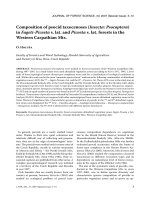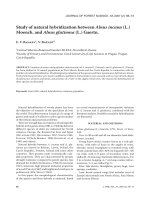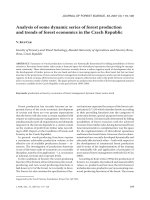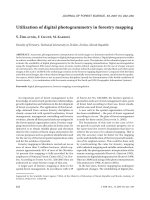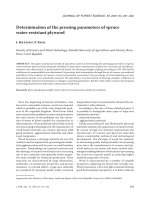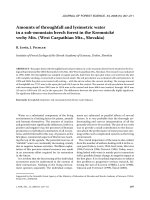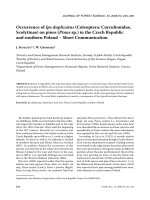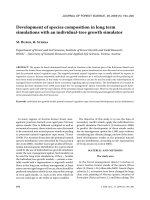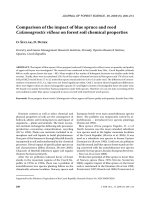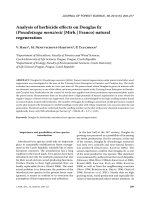Báo cáo lâm nghiệp: "Occurrence of Ips duplicatus (Coleoptera: Curculionidae, Scolytinae) on pines (Pinus sp.) in the Czech Republic and southern Poland – Short Communication" pdf
Bạn đang xem bản rút gọn của tài liệu. Xem và tải ngay bản đầy đủ của tài liệu tại đây (170.2 KB, 3 trang )
234 J. FOR. SCI., 54, 2008 (5): 234–236
JOURNAL OF FOREST SCIENCE, 54, 2008 (5): 234–236
e double-spined spruce bark beetle Ips duplica-
tus (Sahlberg, 1836) occurred only in the Euro-Sibe-
rian taiga from Sweden to Sakhalin and in the Alps
(R 1916; P 1955) until the beginning
of the 20
th
century. Recently, its occurrence has
been confirmed almost in the whole territory of the
Czech Republic up to 600 m a.s.l., rarely at a higher
altitude. Its focus as well as its outbreak is located
in northern Moravia and Silesia (H, K
2007). In southern Poland the occurrence of this
species was detected in the whole area between the
Silesian Upland in the west and Gorce in the east,
up to 1,000 m a.s.l.; sporadic findings were recorded
also in the Western Sudeten (G 2003).
W (1895) reported earlier that this species
attacks not only spruces Picea abies (L.) Karst. (in
orig. Picea excelsa (Link.)), Picea × fennica (Regel.)
Kom. (in orig. Picea excelsa var. uralensis Tepl.) but
also pines Pinus sylvestris L., Pinus sibirica (Du Tour.)
Rupr. (in orig. Pinus cembra L.). K and
S (1948), beside spruce as the main host
tree, described the occurrence on Pinus sylvestris and
sporadically on Pinus cembra; the same information
was repeated by M and M (1999).
According to S (1923), it mostly attacks
spruce as its prime host plant though it is also detect-
ed in various abundances on pines. Feeding outsets
were found on the edge of pine branches; afterwards
they were also found on living pine stems in different
parishes where the pine predominated. Most of the
trees were growing on more or less dry forest soil.
Furthermore, K (1933) noticed the infesta-
tion of both spruce and pine (Pinus sylvestris L.) in
the Białowieża Primeval Forest. S (1952)
also reported Scots pine among possible host trees,
with reference to north-eastern Poland.
Supported by the Ministry of Agriculture of the Czech Republic, Project No. 0002070201.
Occurrence of Ips duplicatus (Coleoptera: Curculionidae,
Scolytinae) on pines (Pinus sp.) in the Czech Republic
and southern Poland – Short Communication
J. H
1,2
, W. G
3
1
Forestry and Game Management Research Institute, Strnady, Frýdek-Místek, Czech Republic
2
Faculty of Forestry and Wood Sciences, Czech University of Life Sciences Prague, Prague,
Czech Republic
3
Department of Forest Management in Mountain Regions, Forest Research Institute, Cracow,
Poland
ABSTRACT: Spruce is regarded as the only host plant of Ips duplicatus in Central Europe, whereas this beetle excep-
tionally occurs on pine in Siberia. Its occurrence on Pinus strobus and Pinus sylvestris was discovered in the eastern part
of the Czech Republic and in southern Poland, where the population density of Ips duplicatus has been increased for
a long time on Norway spruce. However, all cases concerned only single trees which were growing in forest complexes
with spruce dominance. e most likely explanation is merely a consequence of the typical host plant shortage.
Keywords: Ips duplicatus; faunistics; host tree; Pinus; Czech Republic; southern Poland
J. FOR. SCI., 54, 2008 (5): 234–236 235
With reference to M (1994, 1995), the
origin of his data being unsure, I. duplicatus oc-
curs, in addition to spruce, less frequently on pine
(Pinus sylvestris, Pinus sibirica, Pinus koraiensis
Siebold et Zucc.), larch (Larix decidua Miller,
Larix sibirica Lebed., Larix dahurica Turcz. ex
Trautv.), exceptionally on fir (Abies sp.) and rarely
on juniper (
Juniperus sp.). P (1989) summa-
rized only spruces and pines (Picea obovata, Picea
abies (in orig. Picea excelsa), Picea jezoensis (Sieb. et
Zucc.) Carrier., Pinus sylvetris, Pinus sibirica). e
life cycle of I. duplicatus is associated with Picea
abies in Central Europe. Adults infest the upper
part of stems up to tops (P, K 1995)
and thicker branches (H et al. 2003) of 40 to
70 years old stressed trees (P 1955) planted
at sunny places. I. duplicatus inhabits openings
and tends to attack only individual trees inside the
forests (M 1995; G 1999). Lying trees
are attacked only occasionally (P, K
1995; M 1995) or remain not colonized at all
(G 1997).
e occurrence of I. duplicatus on pine was ob-
served in a single locality of the eastern Czech Re-
public, which is characterized by spruce dominance
(but many other tree species grow there):
Oprechtice, Paskovský les wood, 49°43'5.604''N,
18°16'30.519''E, 281 m a.s.l., 30 September 2004,
Pinus strobus L., forest edge. e stem was densely
colonized (more than one entrance hole per 1 dm
2
),
up to a height of 12 m. Extended feeding marks by
I. duplicatus were visible. e beetles of a new gen-
eration during maturation feeding were present; leg.
J. Zátopek, det. et col. J. Holuša;
Oprechtice, Lipina wood, 49°44'2.486''N,
18°15'43.256''E, 269 m a.s.l., 12 November 2007,
Pinus sylvestris, this tree (35 cm in diameter, 22 me-
ters high) was originally growing in a spruce forest
where spruces were cut afterwards. Its stem was
densely colonized (more than one entrance hole
per 1 dm
2
), up to a height of 8 m, in the lower parts
of trees only maturation feedings were found. e
whole life cycle passed and most beetles left the stem;
leg., det. et col. J. Holuša.
Furthermore, the colonization of pine was ob-
served earlier incidentally also in southern Poland:
Grotowice (Forest District Krasiejów, at present
– Opole), 50°35'49.2''N, 17°58'31.3''E, 180 m a.s.l.,
summer 1993, Pinus sylvestris, trees infested densely
along the whole stem length from top to crown,
felled in pine-spruce stands damaged by wind in
1990 (W. Szczepański, personal communication).
I. duplicatus was observed earlier only inciden-
tally on pine in Central Europe, in the old range
of its occurrence. Most probably, it still concerns
only a chance occurrence in new localities with
very high population densities. In the study area in
the Czech Republic, spruces are declining because
of drought and honey fungus attacks and 50–60%
(n = 635) of them are consequently infested by
I. duplicatus
during summer (July–September
2007); a similar pattern could be applied to the
findings in Poland, next to the outbreak area
(G 1997). The incidental infestations on
Scots pine were also observed recently in North-
ern Poland (Kartuzy Forest District), in the newest
outbreak area of I. duplicatus on Norway spruce
(M. Szydlarski, personal communication). These
infestations vary in time and place, but they are
generally spatially related with actual outbreak
areas, where beetles subsequently attack even pine
due to the host plant shortage.
Refe rences
GRODZKI W., 1997. Możliwości kontroli liczebności popu-
lacji kornika zrosłozębnego Ips duplicatus C. R. Sahlb. na
południu Polski. Sylwan, 141: 25–36.
GRODZKI W., 1999. Problematika výskytu lýkožrouta sever-
ského Ips duplicatus (Sahlberg) (Coleoptera: Scolytidae) na
území Polska. Zpravodaj ochrany lesa, 5: 13–15.
GRODZKI W., 2003. Zasięg występowania kornika
zrosłozębnego Ips duplicatus C. R. Sahlb. (Col.: Scolyti-
dae) w obszarach górskich południowej Polski. Sylwan, 8:
29–36.
HOLUŠA J., KNÍŽEK M., 2007. Aktuální rozšíření lýkožrouta
severského v ČR. LOS informuje. Lesnická práce,
85:
314.
HOLUŠA J., ZAHRADNÍK P., KNÍŽEK M., DRÁPELA K.,
2003. Seasonal flight activity of the double-spined spruce
bark beetle Ips duplicatus (Coleoptera, Curculionidae,
Scolytinae) in Silesia (Czech Republic). Biológia (Bratislava),
58: 935–941.
KARPIŃSKI J.J., 1933. Fauna korników Puszczy Białowieskiej
na tle występujących w puszczy typów drzewostanów.
Instytut Badawczy Leśnictwa, Rozprawy i Sprawozdania,
Seria A, 1: 1–68.
KARPIŃSKI J.J., STRAWIŃSKI K., 1948. Korniki ziem Polski.
Annales Universitatis Mariae Curie-Skłodowska, Sectio C,
Supplementum IV, Lublin: 1–239.
MICHALSKI J., MAZUR A., 1999. Korniki. Praktyczny
przewodnik dla leśników. Warszawa, Oficyna Wydawnicza
Wydawnictwo Świat: 1–188.
MRKVA R., 1994. Lýkožrout severský (Ips duplicatus Sahl-
berg), nový významný škůdce na smrku. Lesnická práce,
73: 35–37.
MRKVA R., 1995. Nové poznatky o bionomii, ekologii a hubení
lýkožrouta severského. Lesnická práce, 74: 5–7.
236 J. FOR. SCI., 54, 2008 (5): 234–236
PFEFFER A., 1955. Fauna ČSR. Svazek 6. Kůrovci Sco-
lytidae. (Řád: Brouci – Coleoptera). Praha, Nakladatelství
Československé akademie věd: 324.
PFEFFER
A., 1989. Kůrovcovití (Scolytidae) a jádrohlodovití
(Platypodidae). Praha, Academia: 137.
PFEFFER A., KNÍŽEK M., 1995. Expanze lýkožrouta Ips
duplicatus (Sahlb.) ze severské tajgy. Zpravodaj ochrany
lesa, 2: 8–11.
REITTER E., 1916. Bestimmungstabelle der Borkenkafer
(Scolytidae) aus Europa und den angrenzenden Landern.
Wien Entomologische Zeitung, 32 (Beiheft): 1–113.
SAALAS U., 1923. Die Fichtenkäfer Finnlands. Annales
Academiæ Scientiarum Fennicæ, Serie A, 22: 746.
SCHNAIDER Z., 1952. Kornik zrosłozębny. Las Polski, 12:
33–36.
WACHTL F., 1895. Zur Systematik und Nomenklatur. Mit-
teilungen aus dem Forstlichen versuchswesen Österreichs
(Wien), 19: 1–31.
Received for publication March 5, 2008
Accepted after corrections April 9, 2008
Corresponding author:
Doc. ing. J H, Ph.D., Výzkumný ústav lesního hospodářství a myslivosti, v.v.i., Strnady,
pracoviště Frýdek-Místek, Nádražní 2811, 738 01 Frýdek-Místek, Česká republika
tel./fax: + 420 558 628 647, e-mail:
Výskyt lýkožrouta severského Ips duplicatus (Coleoptera: Curculionidae,
Scolytinae) na borovici (Pinus sp.) v České republice a v jižním Polsku –
Krátké sdělení
ABSTRAKT: Jako hostitelská rostlina je pro Ips duplicatus ve střední Evropě znám jen smrk, zatímco na Sibiři se
výjimečně vyskytuje i na borovici. Výskyt na Pinus strobus a Pinus sylvestris byl zjištěn ve východní části České
republiky a v jižním Polsku, kde jsou dlouhodobě zvýšené populační hustoty Ips duplicatus. Jednalo se však v obou
případech pouze o jednotlivé stromy, rostoucí ve smrkových lesních komplexech. Pravděpodobně se jedná jen
o důsledek nedostatku typické hostitelské rostliny.
Klíčová slova: Ips duplicatus; faunistika; hostitelská rostlina; Pinus; Česká republika; jižní Polsko
